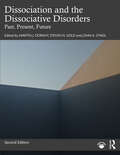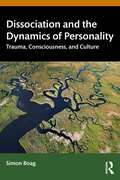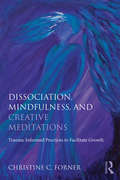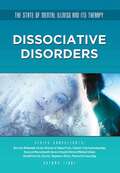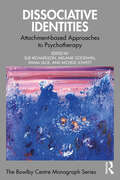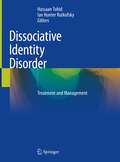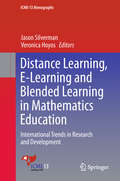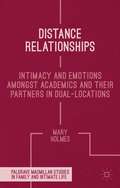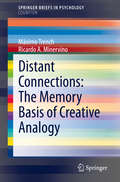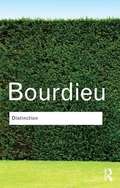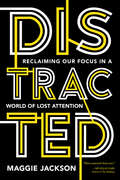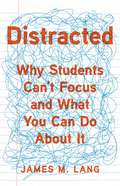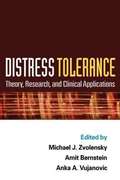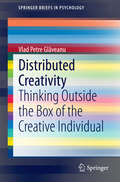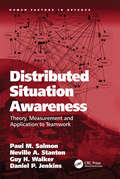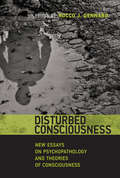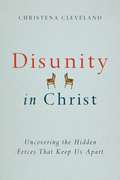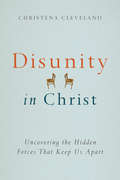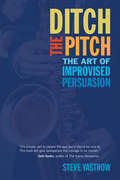- Table View
- List View
Dissociation and the Dissociative Disorders: Past, Present, Future
by Steven N Gold Martin J Dorahy John A O’NeilThis second edition of the award-winning original text brings together in one volume the current thinking and conceptualizations on dissociation and the dissociative disorders. Comprised of ten parts, starting with historical and conceptual issues, and ending with considerations for the present and future, internationally renowned authors in the trauma and dissociation fields explore different facets of dissociation in pathological and non-clinical guises. This book is designed to be the most comprehensive reference book in the dissociation field and aims to provide a scholarly foundation for understanding dissociation, dissociative disorders, current issues and perspectives within the field, theoretical formulations, and empirical findings. Chapters have been thoroughly updated to include recent developments in the field, including: the complex nature of conceptualization, etiology, and neurobiology; the various manifestations of dissociation in clinical and non-clinical forms; and different perspectives on how dissociation should be understood.This book is essential for clinicians, researchers, theoreticians, students of clinical psychology psychiatry, and psychotherapy, and those with an interest or curiosity in dissociation in the various ways it can be conceived and studied.
Dissociation and the Dynamics of Personality: Trauma, Consciousness, and Culture
by Simon BoagDissociation and the Dynamics of Personality addresses the nature of personality in trauma-dissociation and proposes a dynamic understanding of persons that fundamentally challenges conventional views of the self and consciousness.This important book provides a clear and coherent understanding of how childhood trauma can lead to a range of dissociative responses, addressing the fundamental issues underlying the controversy in this field. By recognising causal complexity and the dynamic convergence of biology and culture, Boag demonstrates the significance of trauma-dissociation for understanding personality and consciousness. Drawing upon both philosophy of mind and current psychiatric and neurobiological evidence, this book proposes a dynamic understanding of persons that fundamentally challenges the conventional view of the self and consciousness.Dissociation and the Dynamics of Personality will be of interest to readers concerned with the trauma-dissociation controversy, including philosophers of mind and psychiatrists. It will also interest psychological practitioners and psychologists, as well as anyone concerned with the implications of the dissociative mind for understanding personality.
Dissociation in Traumatized Children and Adolescents: Theory and Clinical Interventions
by Sandra WielandDissociation in Traumatized Children and Adolescents presents a series of unique and compelling case studies written by some of the foremost international experts in the study of dissociation in young people. In the new edition, chapters have been updated to include discussion of the most recent findings in trauma and neuroscience as well as Joyanna Silberg’s popular affect-avoidance model. In addition, Sandra Wieland’s incisive commentaries on each case study have been updated. Each chapter presents a detailed narrative of a therapist's work with a child or adolescent interspersed with the therapist's own thought process, and every therapist explains the theory and research behind her clinical decisions. The case studies present many aspects of working with traumatized children—attachment work, trauma processing, work with the family, interactions with the community, psychoeducation related to dissociation, and encouragement of communication between the dissociated parts—and provide a frank analysis of the difficulties clinicians encounter in various therapeutic situations. While the book is exceptional in its clear and detailed descriptions of theory related to dissociation in children, most importantly, it illustrates how theory can be translated into successful therapeutic interactions.
Dissociation, Mindfulness, and Creative Meditations: Trauma-Informed Practices to Facilitate Growth
by Christine C. FornerDissociation, Mindfulness, and Creative Meditations explores the potential of mindfulness and explains why this level of developmental human achievement is so precarious within traumatic stress, especially traumatic dissociation. Chapters discuss the connection and disconnection between mindfulness and dissociative disorders and highlight the importance of gently creating a mindfulness practice for traumatized individuals. Readers will learn how to exercise the part of the brain that is responsible for mindfulness and how to regulate the part that is responsible for dissociation, and they’ll come away from the book with tips that will help even the most dissociative client to reap the benefits of mindfulness practices.
Dissociative Disorders (The State of Mental Illness and Its Ther)
by Autumn LibalJanet's brain felt foggy and numb. She imagined herself kneeling on a great frozen lake, and she pressed her face against the ice, trying to see through the cloudy surface to the open water below. In fact, she didn't feel any physical sensation at all, just an internal panic. Janet didn't understand these feelings. She just knew that in her frightening daydreams, she was lost above the ice and the knowledge that could save her was trapped in the dark water below. Soon, Janet was forgetting things, missing school, and losing sleep. She'd find notes that she'd written to herself but couldn't remember writing. They said things like, "Janet! Help me!" and "Who are you?" Scariest of all, she began hearing voices in her head that did not sound like her own. When she imagined herself looking down through the barren ice, she thought she saw a little girl looking back at her. Janet was sure the little girl's name was Sara... Have you ever daydreamed, "lost track of time" when you were having fun, or "tuned out" when your parents were scolding you? If so, you were experiencing dissociation. Janet's dissociation, however, is much more severe. She is suffering from dissociative identity disorder. Different parts of her personality have become so separate that they are beginning to seem like different people. A dissociative disorder like Janet's requires medical intervention. Janet's story, and stories like hers, can teach us a lot about how our minds work and how they can be treated. Read Dissociative Disorders and learn more about these psychiatric disorders and the help available for people like Janet.
Dissociative Identities: Attachment-based Approaches to Psychotherapy (The Bowlby Centre Monograph Series)
by Sue RichardsonDissociative Identities draws on expertise from practitioners and survivors to explore therapeutic approaches to dissociation resulting from complex trauma. The contributors provide a vivid insight into what it is like for therapist and survivor to be alongside one another in the therapy room. They highlight the challenges of work with the fragmented internal worlds of those who have survived attachment trauma and explore together what approaches can promote healing and repair.Dissociative identity is reframed from being a disorder to an essential survival skill, and the book includes an open recognition from the perspective of both therapist and survivor of relational challenges, pitfalls, and their impact on the healing process.Dissociative Identities will be invaluable for all professionals working with survivors of complex trauma, including psychotherapists, nurses, social workers, clinical psychologists, and counsellors. It will also be of interest to survivors and their networks.
Dissociative Identity Disorder: Treatment and Management
by Hassaan Tohid Ian Hunter RutkofskyThis book contains new evidence and more ideas for treatment and management of dissociative identity disorder (DID). It is written from the standpoint of an expert in the field for other professionals that deal with or are interested in DID. Chapters are divided into 4 parts. Part 1 acts as an introduction to understanding dissociative identity disorder, such its history, the different types of the disorder, and its portrayal in popular culture. The chapters in this part cover multiple personality disorder, theories, and epidemiology of the disease. Part 2 discusses the pathology and neuroscience of the disease. The comorbidities related to the disorder will be explained, such as PTSD, depression, anxiety, schizophrenia, and more. This part concludes with the potential causes of dissociative identity disorder, which ties into the previously mentioned comorbidities throughout this part. Supplementing the aforementioned topics, Part 3 discusses management of the disease. The chapters will cover modern psychiatry, diagnosis, and treatment options. Drug treatment and psychotherapy are some examples of the treatment options available. The authors share their experiences and perspectives of managing DID, including clinical trials and recovery. Finally, Part 4 discusses the sociology of DID, such as potential drug abuse, social media presence, and the difficulties that psychiatrists face in diagnosing the disease. This part provides advice for clinicians and healthcare providers by sharing different perspectives from psychiatrists that encounter the disease. Written by experts in the field, Dissociative Identity Disorder serves as a valuable resource for psychiatrists and clinicians seeking to understand, treat, and manage the disease.
Distance Learning, E-Learning and Blended Learning in Mathematics Education: International Trends in Research and Development (ICME-13 Monographs)
by Jason Silverman Veronica HoyosThis book builds on current and emerging research in distance learning, e-learning and blended learning. Specifically, it tests the boundaries of what is known by examining and discussing recent research and development in teaching and learning based on these modalities, with a focus on lifelong mathematics learning and teaching. The book is organized in four sections: The first section focuses on the incorporation of new technologies into mathematics classrooms through the construction or use of digital teaching and learning platforms. The second section presents a wide range of perspectives on the study and implementation of different tutoring systems and/or computer assisted math instruction. The third section presents four new innovations in mathematics learning and/or mathematics teacher education that involve the development of novel interfaces’ for communicating mathematical ideas and analyzing student thinking and student work. Finally, the fourth section presents the latest work on the construction and implementation of new MOOCs and rich media platforms developed to carry out specialized mathematics teacher education.
Distance Psychoanalysis: The Theory and Practice of Using Communication Technology in the Clinic (The\library Of Technology And Mental Health Ser.)
by Ricardo CarlinoMany analysts around the world have found themselves in a situation of continuing (or even beginning) psychoanalytic treatment from a distance - either by telephone or other means of communication. No one has found the courage, however, to recognize this as a formal method, as Ricardo Carlino does in this brave, honest, and rigorous book. Freud's ingenious structure of the couch and chair was considered to be the only suitable format for more than one hundred years. Carlino's lucid book takes into account the changes that have taken place in our daily lives, as the result of the resounding technological changes that have influenced our means of communication. Carlino has had the courage to assimilate the changes that have come about in the modern world and argues that Freud's psychoanalytic method can continue to be applied in this new setting. The analytic system, with a patient freely associating his/her occurrences, together with an analyst who listens in silence and communicates his/her interpretation, has remained unaltered.
Distance Relationships
by Mary HolmesDrawing on interviews with UK couples in distance relationships, this book seeks to explain, evaluate and advance sociological debates about intimate life. It provides a rich and human perspective on how bodies, emotions and connections to others are key in maintaining intimate relationships.
Distant Connections: The Memory Basis of Creative Analogy (SpringerBriefs in Psychology)
by Máximo Trench Ricardo A. MinervinoAnalogical thinking lies at the core of human cognition, pervading from the most mundane to the most extraordinary forms of creativity. By connecting poorly understood phenomena to learned situations whose structure is well articulated, it allows reasoners to expand the boundaries of their knowledge. The first part of the book begins by fleshing out the debate around whether our cognitive system is well-suited for creative analogizing, and ends by reviewing a series of studies that were designed to decide between the experimental and the naturalistic accounts. The studies confirm the psychological reality of the surface bias revealed by most experimental studies, thus claiming for realistic solutions to the problem of inert knowledge. The second part of the book delves into cognitive interventions, while maintaining an emphasis on the interplay between psychological modeling and instructional applications. It begins by reviewing the first generation of instructional interventions aimed at improving the later retrievability of educational contents by highlighting their abstract structure. Subsequent chapters discuss the most realistic avenues for devising easily-executable and widely-applicable ways of enhancing access to stored knowledge that would otherwise remain inert. The authors review results from studies from both others and their own lab that speak of the promise of these approaches.
Distinction: A Social Critique Of The Judgement Of Taste (Routledge Classics Ser.)
by Pierre BourdieuNo judgement of taste is innocent - we are all snobs. Pierre Bourdieu's Distinction brilliantly illuminates the social pretentions of the middle classes in the modern world, focusing on the tastes and preferences of the French bourgeoisie. First published in 1979, the book is at once a vast ethnography of contemporary France and a dissection of the bourgeois mind. In the course of everyday life we constantly choose between what we find aesthetically pleasing, and what we consider tacky, merely trendy, or ugly. Taste is not pure. Bourdieu demonstrates that our different aesth.
Distracted: Reclaiming Our Focus in a World of Lost Attention
by Maggie JacksonThis visionary book details the steep costs of our deepening crisis of distraction and reveals remarkable scientific discoveries that can help us rekindle our powers of focus and sustained attention.In the first edition of this groundbreaking book, Maggie Jackson sounded a prescient warning of a looming crisis: the fragmentation of attention that is eroding our abilities to problem-solve, innovate, and care for one another. Now in this updated edition with an incisive new preface, she offers both a renewed wake-up call and a path forward as we reckon with one of the most pressing problems of our time. How can we harness the technological marvels of our age more wisely and turn data into knowledge and distraction into skillful attention? How can we reset human bonds in a time of deep disconnection? We must, she argues, curb technological excess by cultivating the full gamut of our attentional capabilities. We must look first to the human behind the device. Jackson is our expert guide in exploring the historic roots of distraction, the perils we face in melding human and machine, and the cutting-edge science that reveals the attentional skills most needed in an age of overload. Timely and unforgettable, Distracted offers a harrowing yet hopeful account of the fate of our highest human capacity.
Distracted: Why Students Can't Focus and What You Can Do About It
by James M. LangKeeping students focused can be difficult in a world filled with distractions -- which is why a renowned educator created a scientific solution to one of every teacher's biggest problems.Why is it so hard to get students to pay attention? Conventional wisdom blames iPhones, insisting that access to technology has ruined students' ability to focus. The logical response is to ban electronics in class. But acclaimed educator James M. Lang argues that this solution obscures a deeper problem: how we teach is often at odds with how students learn. Classrooms are designed to force students into long periods of intense focus, but emerging science reveals that the brain is wired for distraction. We learn best when able to actively seek and synthesize new information. In Distracted, Lang rethinks the practice of teaching, revealing how educators can structure their classrooms less as distraction-free zones and more as environments where they can actively cultivate their students' attention. Brimming with ideas and grounded in new research, Distracted offers an innovative plan for the most important lesson of all: how to learn.
Distress Tolerance
by Michael Zvolensky Amit BernsteinThis state-of-the-art volume synthesizes the growing body of knowledge on the role of distress tolerance the ability to withstand aversive internal states such as negative emotions and uncomfortable bodily sensations in psychopathology. Prominent contributors describe how the construct has been conceptualized and measured and examine its links to a range of specific psychological disorders. Exemplary treatment approaches that target distress tolerance are reviewed. Featuring compelling clinical illustrations, the book highlights implications of the research for better understanding how psychological problems develop and how to assess and treat them effectively.
Distributed Creativity
by Vlad Petre GlăveanuThis book challenges the standard view that creativity comes only from within an individual by arguing that creativity also exists 'outside' of the mind or more precisely, that the human mind extends through the means of action into the world. The notion of 'distributed creativity' is not commonly used within the literature and yet it has the potential to revolutionise the way we think about creativity, from how we define and measure it to what we can practically do to foster and develop creativity. Drawing on cultural psychology, ecological psychology and advances in cognitive science, this book offers a basic framework for the study of distributed creativity that considers three main dimensions of creative work: sociality, materiality and temporality. Starting from the premise that creativity is distributed between people, between people and objects and across time, the book reviews theories and empirical examples that help us unpack each of these dimensions and above all, articulate them into a novel and meaningful conception of creativity as a simultaneously psychological and socio-material process. The volume concludes by examining the practical implications in adopting this perspective on creativity.
Distributed Free Improvisation: A Cultural Affective-Semiotic Perspective on Creativity (Palgrave Studies in Creativity and Culture)
by Diogo MonzoThis book presents a new model to visualize and understand the creative process in free improvisation: the Interactive Dimensions of the Creative Flow (IDCF). Drawing on theoretical work on distributed creativity and the author&’s background as a professional pianist, this short monograph establishes provocative dialogues between the field of music and the cultural psychology of semiotic dynamics to investigate human interactions involved in the act of creating. New empirical data and literature research on improvisation are used to discuss the historical and sociocultural factors behind collective and collaborative processes. In this context, the Distributed Free Improvisation Model offers a new theoretical and methodological innovation to the study of musical improvisation, which is presented as the result of a musical practice that develops in a community, in sociocultural contexts, through multiple interactions from which the senses and meanings of what is produced emerge. An inspiring read for students, professionals, and researchers in the field of cultural psychology, music improvisation, and creativity studies, this book opens new pathways to the study of creative processes and affective semiosis.
Distributed Situation Awareness: Theory, Measurement and Application to Teamwork (Human Factors in Defence)
by Daniel P. Jenkins Neville A. Stanton Paul M. SalmonHaving an accurate understanding of what is going on is a key commodity for teams working within military systems. 'Situation awareness' (SA) is the term that is used within human factors circles to describe the level of awareness that operators have of the situation that they are engaged in; it focuses on how operators develop and maintain a sufficient understanding of 'what is going on' in order to achieve success in task performance. Over the past two decades, the construct has become a fundamental theme within the areas of system design and evaluation and has received considerable attention from the human factors research community. Despite this, there is still considerable debate over how SA operates in complex collaborative systems and how SA achievement and maintenance is best supported through system, procedure and interface design. This book focuses on the recently developed concept of distributed situation awareness, which takes a systems perspective on the concept and moves the focus on situation awareness out of the heads of individual operators and on to the overall joint cognitive system consisting of human and technological agents. Situation awareness is viewed as an emergent property of collaborative systems, something that resides in the interaction between elements of the system and not in the heads of individual operators working in that system. The first part of the book presents a comprehensive review and critique of existing SA theory and measurement approaches, following which a novel model for complex collaborative systems, the distributed SA model, and a new modelling procedure, the propositional network approach, are outlined and demonstrated. The next part focuses on real-world applications of the model and modelling procedure, and presents four case studies undertaken in the land warfare, multinational warfare and energy distribution domains. Each case study is described in terms of the domain in question, the methodology employed, and the findings derived in relation to situation awareness theory. The third and final part of the book then concentrates on theoretical development, and uses the academic literature and the findings from the case study applications to validate and extend the distributed SA model described at the beginning of the book. In closing, the utility of the distributed SA model and modeling procedure are outlined and a series of initial guidelines for supporting distributed SA through system design are articulated.
Disturbances of the Mind
by Douwe Draaisma Barbara FastingSergei Korsakoff, Alois Alzheimer, James Parkinson, Hans Asperger and other eminent scientists, are all names which have become synonymous with a disease, a syndrome, or an autistic disorder. Although the names of these psychiatrists and neurologists are familiar, we often know little about the individuals themselves and the circumstances surrounding their discoveries. What exactly did they discover, and who were their patients? Douwe Draaisma expertly reconstructs the lives of these and eight other 'names' from the science of mind and brain. Disturbances of the Mind provides a fascinating, illuminating, and at times touching insight into the history of brain research. Thanks to Draaisma's unerring eye and elegant, engaging style, the case histories of Asperger, Bonnet, Capgras, Clérambault, Korsakoff and Gilles de la Tourette syndromes; Alzheimer's and Parkinson's diseases; the areas of Broca and Brodmann; Jackson's epilepsy; and the Gage matrix are all brought to life and transformed into unforgettable tales.
Disturbed Consciousness
by Rocco J. GennaroIn Disturbed Consciousness, philosophers and other scholars examine various psychopathologies in light of specific philosophical theories of consciousness. The contributing authors -- some of them discussing or defending their own theoretical work -- consider not only how a theory of consciousness can account for a specific psychopathological condition but also how the characteristics of a psychopathology might challenge such a theory. Thus one essay defends the higher-order thought (HOT) theory of consciousness against the charge that it cannot account for somatoparaphrenia (a delusion in which one denies ownership of a limb). Another essay argues that various attempts to explain away such anomalies within subjective theories of consciousness fail.Other essays consider such topics as the application of a model of unified consciousness to cases of brain bisection and dissociative identity disorder; prefrontal and parietal underconnectivity in autism and other psychopathologies; self-deception and the self-model theory of subjectivity; schizophrenia and the vehicle theory of consciousness; and a shift in emphasis away from an internal (or brainbound) approach to psychopathology to an interactive one. Each essay offers a distinctive perspective from the intersection of philosophy, consciousness research, and psychiatry.ContributorsAlexandre Billon, Andrew Brook, Paula Droege, Rocco J. Gennaro, Philip Gerrans, William Hirstein, Jakob Hohwy, Uriah Kriegel, Timothy Lane, Thomas Metzinger, Erik Myin, Inez Myin-Germeys, Myrto Mylopoulos, Gerard O'Brien, Jon Opie, J. Kevin O'Regan, Iuliia Pliushch, Robert Van Gulick
Disturbed Consciousness: New Essays on Psychopathology and Theories of Consciousness (Philosophical Psychopathology)
by Rocco J. GennaroEssays defend, discuss, and critique specific theories of consciousness with respect to various psychopathologies.In Disturbed Consciousness, philosophers and other scholars examine various psychopathologies in light of specific philosophical theories of consciousness. The contributing authors—some of them discussing or defending their own theoretical work—consider not only how a theory of consciousness can account for a specific psychopathological condition but also how the characteristics of a psychopathology might challenge such a theory. Thus one essay defends the higher-order thought (HOT) theory of consciousness against the charge that it cannot account for somatoparaphrenia (a delusion in which one denies ownership of a limb). Another essay argues that various attempts to explain away such anomalies within subjective theories of consciousness fail.Other essays consider such topics as the application of a model of unified consciousness to cases of brain bisection and dissociative identity disorder; prefrontal and parietal underconnectivity in autism and other psychopathologies; self-deception and the self-model theory of subjectivity; schizophrenia and the vehicle theory of consciousness; and a shift in emphasis away from an internal (or brainbound) approach to psychopathology to an interactive one. Each essay offers a distinctive perspective from the intersection of philosophy, consciousness research, and psychiatry.ContributorsAlexandre Billon, Andrew Brook, Paula Droege, Rocco J. Gennaro, Philip Gerrans, William Hirstein, Jakob Hohwy, Uriah Kriegel, Timothy Lane, Thomas Metzinger, Erik Myin, Inez Myin-Germeys, Myrto Mylopoulos, Gerard O'Brien, Jon Opie, J. Kevin O'Regan, Iuliia Pliushch, Robert Van Gulick
Disulfiram: Its Use in Alcohol Dependence and Other Disorders
by Avinash De SousaThis book focuses on the value of supervised Disulfiram therapy, highlighting the many potential and unique benefits of Disulfiram. One of the oldest drugs available for the long-term management of alcohol dependence, Disulfiram remains a viable treatment option for alcohol dependence and has been shown in recent studies to be more successful in treating patients with alcohol dependence than Naltrexone, Topiramate and Acamprosate. It is also useful in dual diagnosis patients and those with co-morbid cocaine and alcohol dependence. Although Disulfiram’s mechanism of action in alcohol dependence was long thought to be its effects as a psychological deterrent, more recent studies point to potential anti-craving effects as well. In dedicated chapters, the book reviews major clinical trials of Disulfiram spanning nearly 60 years, its historical aspects and discovery, side effects, treatment protocols and uses in the context of alcohol dependence. The book also discusses the use of Disulfiram across diverse populations along with monitoring for compliance and various adverse effects that may manifest. Further topics include Disulfiram implant therapy and the role of Disulfiram in the modern long-term pharmacotherapy of alcohol dependence, as well as the role of cognitive behavior therapy in enhancing the effects of Disulfiram and the emerging role of Disulfiram in treating cocaine dependence and pathological gambling. As such, the book offers a “one-stop” comprehensive guide to all aspects of Disulfiram therapy.
Disunity in Christ: Uncovering the Hidden Forces That Keep Us Apart
by Christena ClevelandDespite Jesus' prayer that all Christians "be one," divisions have been epidemic in the body of Christ from the beginning to the present. We cluster in theological groups, gender groups, age groups, ethnic groups, educational and economic groups. We criticize freely those who disagree with us, don't look like us, don't act like us and don't even like what we like. Though we may think we know why this happens, Christena Cleveland says we probably don't. In this eye-opening book, learn the hidden reasons behind conflict and divisions. Cleveland brings to bear the latest studies and research on the unseen dynamics at work that tend to separate us from others. Learn why Christians who have a heart for unity have such a hard time actually uniting. The author provides real insight for ministry leaders who have attempted to build bridges across boundaries. Here are the tools we need to understand how we can overcome the hidden forces that divide us.
Disunity in Christ: Uncovering the Hidden Forces that Keep Us Apart
by Christena ClevelandLeadership Journal2014 Readers' Choice Awards Honorable MentionWhy I think all my friends are unique but those in other groups are all the sameWhy little differences often become big sources of conflictWhy categorizing others is often automatic and helpful but can also have sinister side effectsWhy we are so often victims of groupthink and how we can avoid itWhy women think men are judging them more negatively than men actually are, and vice versaWhy choices of language can actually affect unity
Ditch the Pitch
by Steve YastrowIn today's world, customers don't want to hear sales pitches, but so many salespeople still rely on them. In his breakthrough handbook, Ditch the Pitch, Steve Yastrow, founder of a successful business strategy consulting firm, asks us to throw out everything we've been taught about pitching to customers. Steve's advice: tear up your sales pitch and instead improvise persuasive conversations. Ditch the Pitch is an essential read for salespeople, business managers, and anyone wishing to persuade those around them. Organized into six habits, with each habit consisting of three practices necessary for mastery, Ditch the Pitch is designed to teach Yastrow's approach to fresh, spontaneous, persuasive conversations. These new skills will show the reader how to identify the details that make each customer unique and subsequently navigate a conversation that focuses on the right message for the right customer at the right time. Throughout the book, the author quotes well-known improv comedians and musicians. He translates the techniques these artists use when improvising to create persuasive situations with customers. With the new confidence Ditch the Pitch offers, you will become master of the art of on-the-spot, engaging, and effective customer interactions. Let go of pre-written scripts and embrace Yastrow's guidelines for effortlessly enabling spontaneous conversations that persuade customers to say "yes. "
